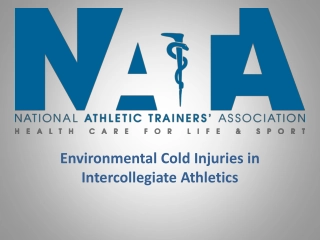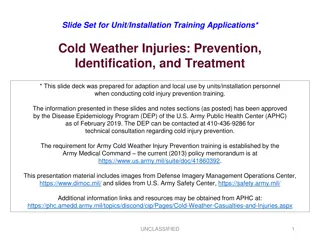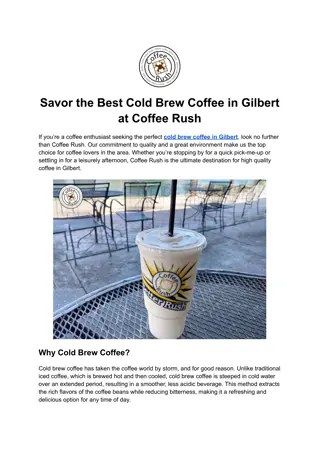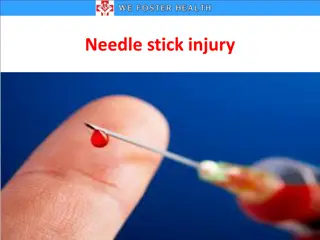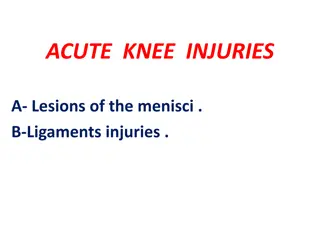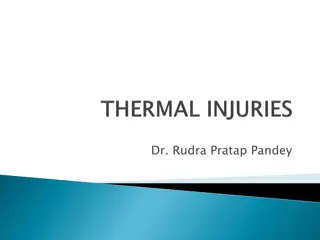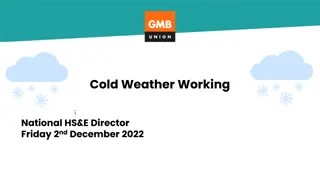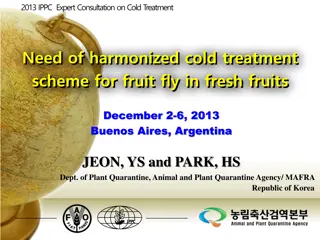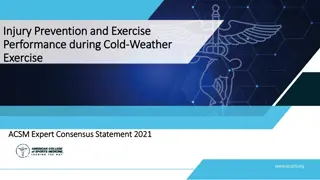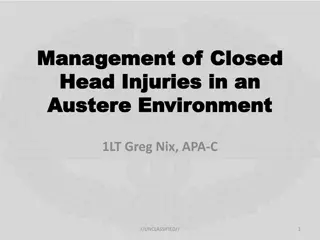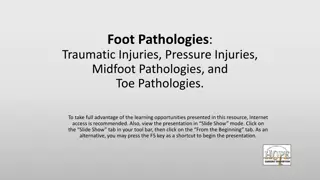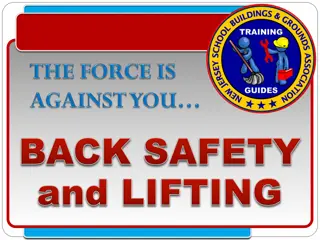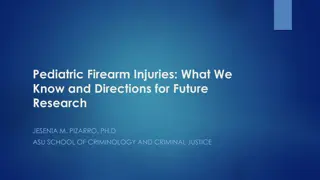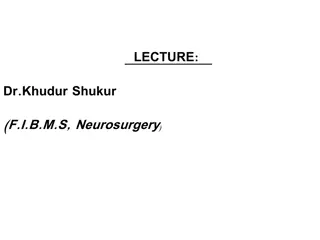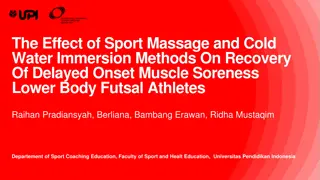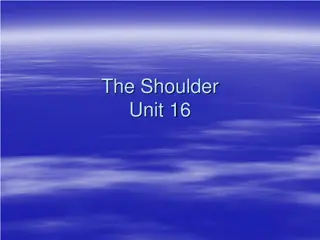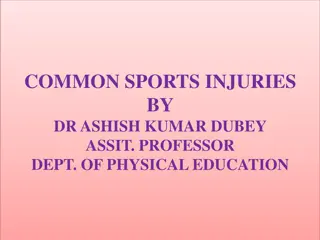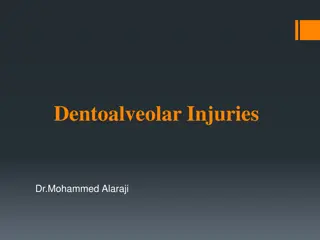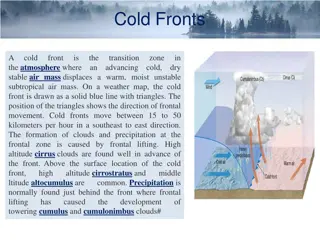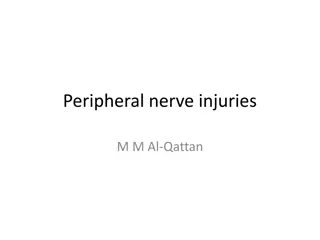Spinal injuries
An overview of spinal injuries, including anatomy revision, types of spinal fractures, assessment, management, and common patterns of injuries. It also covers back pain presentation, red flags, differentials, and the structure of vertebrae. The Denis classification of spinal fractures and the most c
3 views • 40 slides
Environmental Cold Injuries in Intercollegiate Athletics
Learn about environmental cold injuries in intercollegiate athletics, including hypothermia, frostbite, and chilblains. Understand the recognition signs and proper treatment methods to address these conditions promptly.
6 views • 10 slides
Comprehensive Guide on Injury, Poisoning, and External Causes
This detailed guide covers various aspects of injuries, poisonings, and other consequences from external causes. It includes information on ICD10 and ICD9 coding, recording and treatment details, vocabulary related to different types of injuries, body parts classification, and code structures for di
2 views • 39 slides
Needlestick Injuries Prevention and Safety
Prevent needlestick injuries by avoiding unnecessary needle use, using devices with safety features, and implementing safe work practices. Healthcare professionals should report injuries promptly, participate in training, and get vaccinated. Be cautious when handling surgical sharps to prevent injur
5 views • 10 slides
Cold Weather Injuries Prevention Training
This slide deck focuses on preventing, identifying, and treating cold weather injuries. It emphasizes the responsibility of both individuals and commands in preventing cold injuries, highlighting factors contributing to susceptibility and methods for regulation body temperature in cold environments.
3 views • 41 slides
Savor the Best Cold Brew Coffee in Gilbert at Coffee Rush
Do you need that cup of coffee fix or a cup of juice to boost you up in Gilbert? Who can offer you the refreshing taste of Cold Brew Coffee in Gilbert? Coffee Rush does!Brewed from well-selected coffee beans, Special T Cold Brew Coffee is brewed using cold water for a longer time to give you the bes
1 views • 3 slides
Understanding Needle Stick Injuries and Prevention
Needle stick injuries are percutaneous piercing wounds caused by needles or other sharp instruments. They pose significant risks, including exposure to blood-borne diseases. Health-care workers are particularly vulnerable, with millions experiencing such injuries annually. Proper training, safe prac
0 views • 35 slides
Understanding Acute Knee Injuries: Meniscal Tears and Ligament Injuries
Acute knee injuries, such as meniscal tears and ligament injuries, are commonly caused by trauma or twisting motions. Meniscal tears can lead to pain, swelling, and locking of the knee joint, especially in young active individuals. Understanding the anatomy of the knee joint and meniscus, along with
0 views • 56 slides
Cold-Related Injuries and Conditions Overview
Explore the definition, presentation, and treatment of non-freezing cold-related injuries like trench foot, chillblains, panniculitis, and cold urticaria. Learn about the characteristics, observations, and diagnosis of these conditions and understand the risks associated with frostbite in specific a
0 views • 33 slides
Understanding Vehicle Collisions: Causes, Types, and Injuries
Vehicle collisions involve various types such as front impacts, side impacts, and rear-end collisions, resulting in different injuries like back and head injuries, neck injuries, soft tissue damage, broken bones, and internal injuries. Understanding the causes and effects of collisions can help prev
0 views • 14 slides
Overview of Burn and Scald Injuries and Classification
Burn injuries from dry heat and scald injuries from hot liquids or steam are common forms of thermal injuries. Other etiological classifications include exposure to chemicals, electrical energy, and radiation. The extent of tissue damage is directly related to temperature and duration. Classificatio
1 views • 31 slides
First Aid Tips for Common Trauma Injuries
Learn how to manage various trauma injuries such as skull fractures, eye injuries, blowout fractures, epistaxis, mouth injuries, soft tissue injuries, open injuries, and penetrating wounds with practical first aid techniques. From treating bleeding and impaled objects to saving dislodged teeth and c
0 views • 16 slides
Innovations in Cold Storage Rack Design
Flamingo introduces a tool for designing efficient cold storage racks, addressing challenges in storing rarely accessed cold data at low cost. By leveraging innovative approaches like custom racks and resource optimization, the design complexity and performance impact are managed effectively. The so
0 views • 15 slides
Preventing Road Traffic Injuries: A Global Perspective
Road traffic injuries are a significant global issue, causing millions of deaths and injuries annually. This report highlights the complexity and dangers of road traffic systems, emphasizing the need for increased awareness and preventive measures at governmental, industrial, and individual levels.
1 views • 27 slides
Complications of Fractures: Types and Risks
Complications of fractures can be classified as general, local early, and late complications. General complications include shock, embolisms, and fever while local complications involve injuries to nearby tissues and infections. Early local complications can lead to visceral, vascular, nerve injurie
0 views • 29 slides
Understanding the Risks of Working in Cold Weather
Working in cold weather conditions can lead to various health risks, including frostbite, hypothermia, and musculoskeletal disorders. Employers should have policies and procedures in place to protect workers from the impacts of extreme cold, such as reduced performance and increased risk of accident
0 views • 20 slides
Harmonized Cold Treatment Scheme for Fruit Fly in Fresh Fruits Expert Consultation
The 2013 IPPC Expert Consultation in Buenos Aires, Argentina discussed the need for a harmonized cold treatment scheme for fruit flies in fresh fruits. The goal was to control regulated pests in international trade and suggest experiments for harmonizing cold treatment protocols. Prohibited articles
0 views • 13 slides
Cold Weather Exercise Injury Prevention and Treatment Guidelines
This expert consensus statement by the ACSM provides comprehensive information on preventing and treating cold injuries during exercise. It covers frostbite, hypothermia, snow blindness, and other cold-related conditions, emphasizing the importance of understanding risk factors, prevention strategie
1 views • 17 slides
Understanding Mechanical Injuries: Types, Classification, and General Principles
Mechanical injuries encompass a variety of harms caused to the body, mind, reputation, or property. These injuries can be classified into medical, legal, and medico-legal categories based on factors like intentionality. The types of mechanical injuries range from blunt force trauma to thermal, chemi
0 views • 79 slides
Management of Closed Head Injuries in an Austere Environment Overview
Understanding the pathophysiology of brain injuries, including intracranial pressure changes and specific injuries such as traumatic brain injury (TBI), skull fractures, brain bleeds, and diffuse axonal injuries. It covers classifications, diagnosis, and treatment approaches for mild/concussion, mod
0 views • 27 slides
Cold Weather Pit Count Coordinator Module 3 Planning for Success
Cold weather presents challenges for conducting pit counts to address homelessness. Visibility of homelessness decreases in cold weather, making locating individuals more challenging. Planning ahead with contingency dates, volunteer coordination, and route planning is crucial for success in cold wea
0 views • 11 slides
Understanding Foot Pathologies: Traumatic Injuries and Pressure Injuries
Explore common foot pathologies including traumatic injuries like plantar fasciitis, turf toe, and sprains, as well as pressure injuries such as plantar ulcers and heel spurs. Learn about the causes, symptoms, and treatment options for these conditions.
0 views • 33 slides
Understanding Back Injuries and Prevention Methods
More than 1 million workers suffer from back injuries each year, accounting for a significant portion of workplace injuries. These injuries are not only painful but can also have long-term effects. It is crucial to learn how to avoid injuring or re-injuring your back to prevent pain and avoid potent
1 views • 32 slides
Understanding Pediatric Firearm Injuries and Future Research Directions
Pediatric firearm injuries are a significant public health concern, with thousands of American children affected annually. Research gaps exist in understanding the causes, consequences, and prevention strategies for pediatric firearm injuries. The lack of surveillance data and research funding hinde
0 views • 16 slides
Understanding Injuries to the Cervical and Thoracolumbar Spine
Cervical spine injuries are common, especially in the 15-30 age group, with motor vehicle accidents, falls, and sports being major causes. Male individuals are more prone to injuries. Neurological deficits are associated with specific types of injuries, necessitating prompt imaging for spinal cord i
0 views • 20 slides
Advanced Cooling Solutions: ACS Cold Plate Focus Areas
Introduction to ACS Cold Plate focus areas led by Jessica Gullbrand from Intel. The objective is to standardize liquid-cooled solutions without hindering innovation. The ongoing focus includes approval of cold plate requirements, initiation of Open Rack V3 Blind Mate Liquid Cooling, and various work
0 views • 20 slides
Financial Impact of Cold Agglutinin Screen for Diagnosis of Cold Agglutinin Disease
Cold agglutinin disease, a rare form of autoimmune hemolytic anemia, accounts for 15% of AIHA cases. Implementing a cold agglutinin screen for diagnosis can have significant financial implications in healthcare costs. This condition is characterized by the presence of cold agglutinins, primarily IgM
0 views • 30 slides
Improving Southern Warehouse: Cold Storage Project Proposal
The Division of Food and Nutrition at agri.nv.gov is proposing a capital improvement project for the Southern warehouse to address challenges with third-party cold storage. The current arrangement has led to food spoilage, delivery delays, and compliance difficulties. The proposal aims to develop on
0 views • 10 slides
Analysis of Cold Fronts and Metal Distribution in Cluster A496
In a detailed study using XMM-Newton observations, the metal distribution and correlation with cold fronts in cluster A496 were analyzed. Cold fronts induced by minor mergers and sloshing mechanisms were investigated, revealing discontinuities and temperature variations indicative of cold fronts. Mu
0 views • 16 slides
Understanding Pressure Ulcers and Tissue Injuries Progression
Pressure ulcers, also known as pressure injuries, are localized damages to the skin and underlying soft tissue usually over bony prominences. The National Pressure Ulcer Advisory Panel changed the terminology in 2016 to classify all stages as injuries, not just ulcers. Stages range from non-blanchab
0 views • 13 slides
Understanding Birth Injuries in Newborns
Birth injuries in newborns can result from various factors during the birthing process, such as soft tissue injuries and head trauma. Soft tissue injuries like facial abrasions and scleral hemorrhage may occur due to causes like dystocia and forceps delivery. Nursing care involves assessing and reas
0 views • 19 slides
The Effect of Sport Massage and Cold Water Immersion on Muscle Soreness Recovery in Futsal Athletes
A study investigated the impact of sport massage and cold water immersion on recovery from delayed onset muscle soreness in lower-body futsal athletes. Results indicated that cold water immersion had a more significant effect on recovery compared to sport massage. The cold-water immersion method sho
0 views • 7 slides
Understanding Upper Extremity Injuries and Shoulder Physiology
Upper extremities are prone to various injuries in sports, including sprains, strains, dislocations, fractures, and repetitive motion injuries like arthritis and tendonitis. The shoulder complex involves bones, muscles, tendons, ligaments, and articulations. Joints like the sternoclavicular, acromio
0 views • 63 slides
Understanding Common Sports Injuries by Dr. Ashish Kumar Dubey
Dr. Ashish Kumar Dubey, Assistant Professor in the Department of Physical Education, categorizes common sports injuries into soft tissue injuries, bone injuries, and joint injuries. Soft tissue injuries include sprains, strains, contusions, abrasions, lacerations, and incisions. Sprains are ligament
0 views • 7 slides
Understanding Dentoalveolar Injuries: Causes and Classification
Dentoalveolar injuries refer to trauma affecting the teeth and their supporting structures. These injuries can range from isolated incidents to significant maxillofacial damage. They are classified into categories based on the affected tissues, including hard dental tissues, pulp, periodontal tissue
1 views • 18 slides
Understanding Cold Fronts and Occluded Fronts in Weather Systems
Cold fronts occur when advancing cold, dry air displaces warm, moist air, causing changes in temperature, winds, precipitation, and pressure. Occluded fronts result from a cold front overtaking a warm front, leading to the formation of mid-latitude cyclones. Different types of occlusions, like the c
0 views • 13 slides
Understanding Death from Starvation and Cold: Mechanisms and Lesions
Starvation and cold can lead to death through specific mechanisms that affect the body's metabolism and tissue integrity. In cases of starvation, the body breaks down fat stores, leading to organ damage and eventual death. For cold-related deaths, exposure to extreme temperatures disrupts metabolic
0 views • 17 slides
Overview of Peripheral Nerve Injuries and Brachial Plexus Injuries
Explore different types of peripheral nerve injuries including Erb's palsy, Klumpke palsy, isolated axillary nerve injury, and isolated musculocutaneous nerve injury. Learn about the anatomy, causes, motor and sensory exams, and management of these injuries. Understand the myotomes and dermatomes as
0 views • 19 slides
Comprehensive Guide to Burn Injuries and Treatment
Burn injuries are caused by various factors such as heat, cold, electricity, chemicals, or radiation. This guide covers the pathophysiology of burns, immediate care steps, pre-hospital and hospital care, criteria for admission to a burn unit, and the impact of inhalational injuries. Learn about how
0 views • 63 slides
Understanding Finger Injuries and Proper Assessment Guidelines
Hand injuries, especially finger injuries, are common in emergency departments. Proper diagnosis and management are crucial to prevent long-term complications. This content covers information on tendon anatomy, nerve innervation, and assessment guidelines for finger injuries.
0 views • 67 slides

